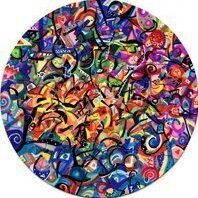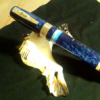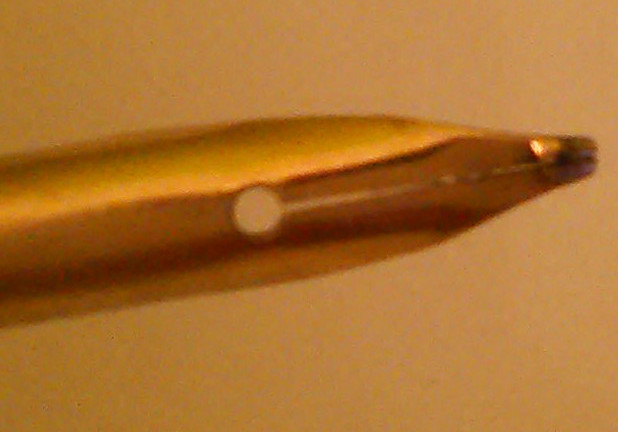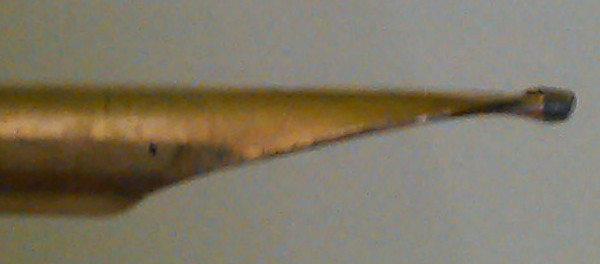Search the Community
Showing results for tags 'experiment'.
-
Not sure if this is the right forum or if there even is a rightful place for it on FPN. I'm experimenting with a concertina prototype for my students. (The fold-and-cut concertina template isn't mine.) This first attempt is just on printer paper, as I wasn't sure if I would be messing up right from the start. It's certainly the wrong paper, as everything soaks through and you can barely tell back from front. I'll use better paper for my students, but for my purposes it was fine that the page had two inky sides. First I put down a little bit of crayon as a resist, but it didn't really do anything. Then I splashed some FP ink around, dragged some of it with a comb, picked some of it up with a wet paper towel & dabbed it around, then dried the page in the sun. After that, borrowing Nick Stewart's tip about using bleach to react with the ink, I created some random negative spaces. To play with texture, I used wadded-up plastic wrap dipped in watered-down bleach. Dried the page again. Finally, I cut & folded the paper into a concertina, and used the random shapes to prompt outlines of memories with darker ink (Brun Prévenance, Jacques Herbin Scented. Despite the cool smell, I don't care for the ink).
- 27 replies
-
- art
- experiment
-
(and 1 more)
Tagged with:
-
Well... Jinhao 159, with a generic Jinhao nib. Okay. That top line is disgusting, but I made my Jinhao nib flex. Yes, it is prone to springing the nib if brought too far, but so far, the modifications on the nib are looking okay. The middle line is it's "average" flex (without any risk). The bottom lines however.... that's a whole different story. Right next to it, I compared the flex to a Canadian Parker Vacumatic. 1 millimeter to 2.5 millimeter flex average. The really crazy ones go up to 3 millimeters.
- 3 replies
-
- flex
- experiment
-
(and 1 more)
Tagged with:
-
Yesterday a box arrived bearing my new Pilot Custom 74 with a soft fine nib. I feel like I already know this pen to a certain extent since it is an exact replacement for one that was stolen, but I am still faced with a conundrum: which ink do I use to welcome it into the collection? My own process involves determining the pen's vibe and finding an ink that complements that vibe along with the color. So in this case the pen itself is rather plain, so I'll want an ink that has some liveliness but isn't frivolous. I don't ink more than four or five pens at a time so I try to vary the kinds of colors I have available. This is both a hue/value thing (I have a bunch of inks in my favorite families and try not to have more than one in a pen at the same time) and a tone thing (some inks are serious, some are punchy, some are contemplative so I try to keep a mix to match my moods as they change). Apart from these highly subjective questions, I also want to get a good gauge of how the pen performs. Using an ink with which I'm familiar gives me a more reliable gauge of performance, but I have a ton of samples I'm itching to try out. The welter of questions often produces a delicious flurry of indecision that can last for several days. Right now I'm leaning toward Colorverse Andromeda even though it breaks all of my rules. I suspect that it is too frivolous for this pen, I have two other pens inked with what I broadly consider "red", one of which has Yama-budo (although I'm considering flushing that one; it's a TWSBI mini and they don't really seem to go together), and I'm new to Colorverse as a brand (my other current "red" ink is Dark Energy, which is my first full Colorverse fill) and have never tried Andromeda. So how do the rest of you approach the first fill of a new pen? What questions do you ask yourself? Do you use a standard ink? Why?
- 25 replies
-
- new pens
- experiment
-
(and 1 more)
Tagged with:
-
I've been quite dissatisfied with the nib of my Parker 51. It had some sort of a broad nib, maybe a factory oblique, maybe worn out, maybe ground by someone. We'll never know. I had two issues with it: This shape was probably never meant for left-handed use.The nib had a very narrow sweet spot and produced extreme skipping and scratchiness outside it.It was too broad for my taste.If you look at the pictures, you can see that it had this weird angled surface at the end of its tipping. That surface was the sweet spot. So I took the plunge and decided to do something about it. I went into an OBI shop to buy some grinding stuff - unfortunately, the finest they had was K1200. Anyway, I thought I'd experiment with more, so I bought a K240, K600 and K1200. I took off the hood (fortunately I hadn't sealed it yet) and took out the nib for a ride. K240 was useless, probably too rough to do anything to the nib. K600 was quite nice - I could very quickly grind away the angled surface and make the two tines equally large. After that, I flattened the top and bottom a bit, just enough to give a little line variation, but I wouldn't dare call it italic. At this point, the nib felt already better and didn't skip anymore. But it was very scratchy. I grabbed the K1200 paper and started to polish it. First I just stroked it on the grinding surface, then I inserted it into the collector and started moving it as if I was writing with it. Finally, I put together the pen, filled with some ink, and tested it. Then I polised some more, writing actual words on the K1200 paper. (Ink could be wiped off from it with just a paper tissue.) Here's how it looks: As a result, I no longer have any issues writing with it left-handedly. The nib has a new sweet spot which is much wider than before and now fits the way I hold the pen. I guess I could still make it even better if I had more patience and an even finer piece of polishing paper. Here are some thoughts for anyone that wants to try it at home. Only do this to pens that you wouldn't feel very sorry about, should you ruin the nib.Be very careful. You can't grow back what you ground off.You really don't need to apply much pressure.Grinding paper is probaly not the right tool, but it can do the job.The finer grinding surface you can use, the smoother your nib will be. Thanks for reading! If you have any advice on how to do it even better, I'm always curious to know more.
-

How Many Pages Can You Get Out Of A Standard International Cartridge?
yogalarva posted a topic in Fountain & Dip Pens - First Stop
*Note - sorry if this should be in a different sub-forum. Mods, please feel free to move it if you feel necessary. :-) I’m pretty much ready to pull the trigger on an Al Sport, so I decided to do a few tests this weekend to see just how much writing I can get out of a standard international cartridge. And, since I’m such a generous person, I figured I would share my results with anyone else who might be curious. For my first data point I grabbed a no-name black cartridge that I have and stuck it in my only pen that will take standard internationals (from now on, I’m going to use S.I.C. = standard international cartridge), my Nemosine Singularity with a Goulet 1.5 mm stub. I started making lines of loops until I used up all the ink. This test was done on my standard for ink reviews - Staples 24 lb bright white inkjet paper. I know the picture above might be hard to decipher with so many angles, but I got exactly 7.5 pages of loops out of the cartridge (1 page = 1 side of a piece of paper). I would like to have stopped there, but too many years to training in the scientific process does not allow me to make claims based on a single trial. If I had enough time and patience I would run through a myriad of a combinations of ink and paper, but I have other things to do, so I tried one further run. This time I refilled the same cart with Pelikan Edelstein Aventurine, popped it back into the pen, and put the nib to some A4 Miquelruis notebook paper. Instead of just doing loops, I wanted to do some writing more true to real life. I chose one of my favorite novels and began transcribing it, which took quite a bit longer than I expected. This time the ink ran out just at the bottom of page 9. I also found that the ink flow was much wetter and more consistent than I usually get using the converter with this pen, which was a nice change. Based on the limited statistics of my N=2 experiment, I would estimate that a S.I.C. will write for 7-10 pages. Obviously, this will vary depending on how much pressure you write with, your nib size, the paper absorbency, if you are drawing as well as writing, etc. I’m impressed and I would say that this has convinced me that I could use a pen that takes only S.I.C.’s and have it not be too cumbersome to use in my daily life. Especially since refilling carts is not that hard, and I’m going to experiment today with a way to reseal them so that I can have an extra with me in any color I want.












